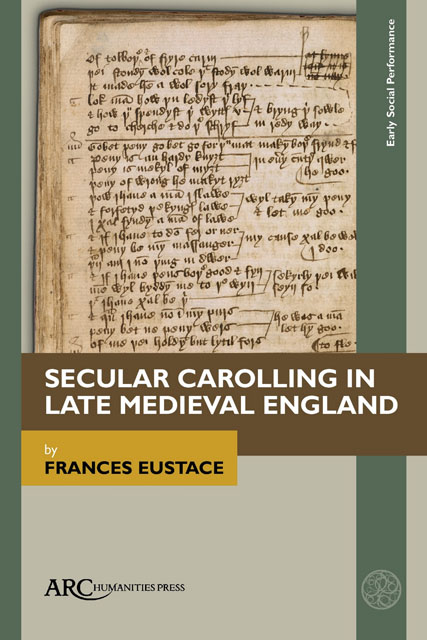Book contents
- Frontmatter
- Contents
- List of Illustrations
- Preface
- Introduction
- Chapter 1 Carolling and Dance-Song in the Context of a Primarily Oral Culture
- Chapter 2 Courtly Carolling: Contexts and Practices
- Chapter 3 The Church, Carolling, and the Emergence of the English Franciscan Carole Writers of The Fourteenth and Fifteenth Centuries
- Chapter 4 Carole Texts in Context: The Manuscripts
- Chapter 5 Carole Texts as Witnesses to Carolling Practice
- Chapter 6 Survivances Of Carolling In Folk Culture
- Conclusion: Carolling from a Dance Movement Psychotherapy Perspective
- Bibliography
- Index
- Frontmatter
- Contents
- List of Illustrations
- Preface
- Introduction
- Chapter 1 Carolling and Dance-Song in the Context of a Primarily Oral Culture
- Chapter 2 Courtly Carolling: Contexts and Practices
- Chapter 3 The Church, Carolling, and the Emergence of the English Franciscan Carole Writers of The Fourteenth and Fifteenth Centuries
- Chapter 4 Carole Texts in Context: The Manuscripts
- Chapter 5 Carole Texts as Witnesses to Carolling Practice
- Chapter 6 Survivances Of Carolling In Folk Culture
- Conclusion: Carolling from a Dance Movement Psychotherapy Perspective
- Bibliography
- Index
Summary
I HAVE DANCED, on and off, since I was two years old and had some aspirations, until bassoon playing took over aged thirteen. When I needed some time out of the music profession, in 1995, I trained as a Dance Movement Psychotherapist and worked in that field for the next ten years. A group therapy session usually begins with the formation of an inward facing circle in which the members can acknowledge each other, and the leader (the therapist) can encourage some level of synchrony, to express empathy and cohesion. Later the circle may break up as the members are able to express themselves individually, the group being brought back to the circle at the close.
When I became a medievalist, I was struck by the resonances between this experience and the ancient activity of carolling. This book is a result of my fascination with this connection. I wish to thank Prof. Pamela King, who encouraged me to start this research and supervised my doctorate at the beginning, Prof. Emma Hornby who took over and saw me through, and Prof. Leah Tether who injected much needed enthusiasm towards the end. I also thank Prof. Christopher Page who generously gave me his research reference notes in a private email and assured me that he was happy for me to make use of them. I am grateful to Prof. King for working alongside me in reworking and rewriting the doctorate into a published monograph.
- Type
- Chapter
- Information
- Secular Carolling in Late Medieval England , pp. viii - ixPublisher: Amsterdam University PressPrint publication year: 2022

